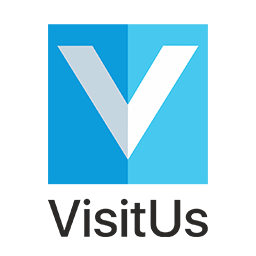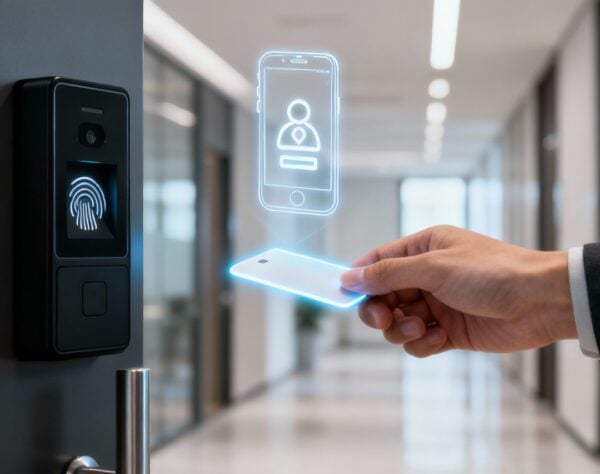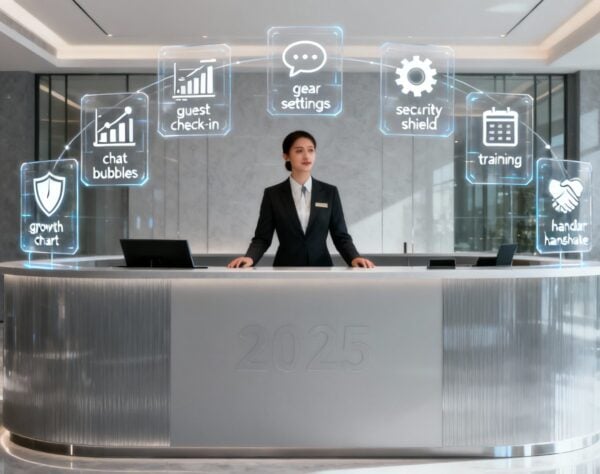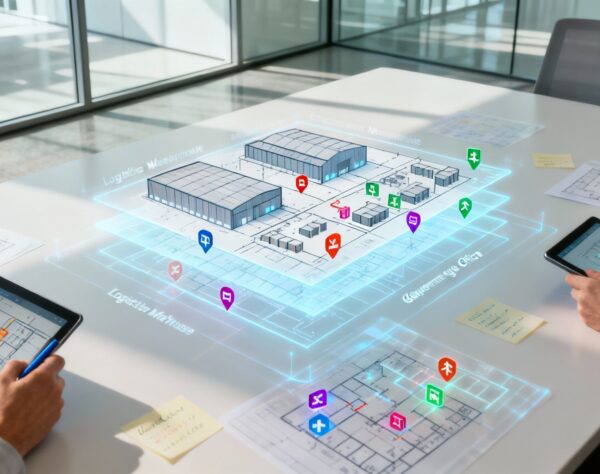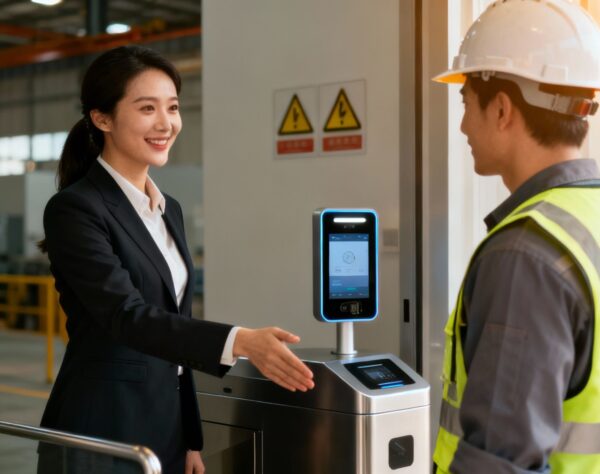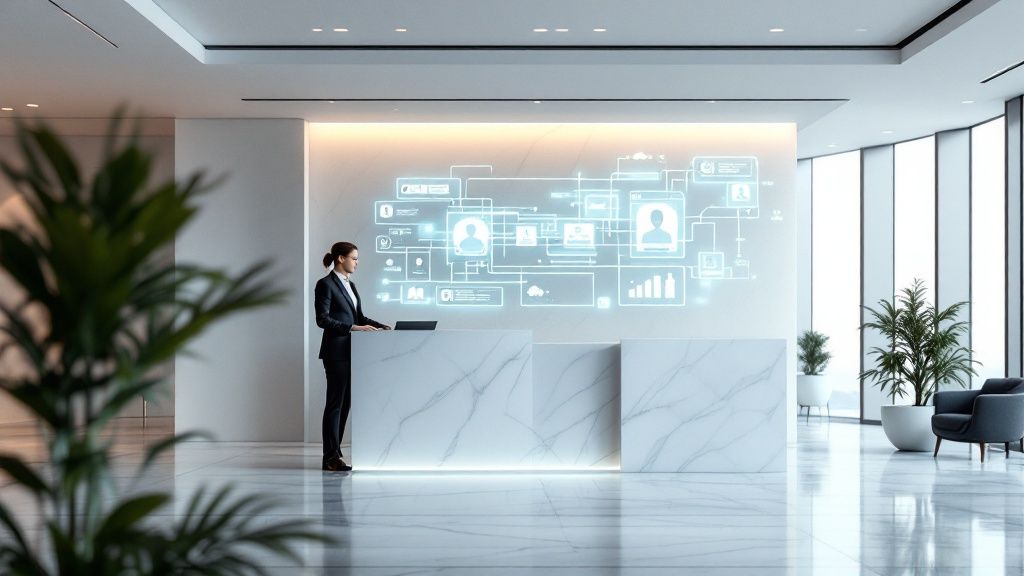
The Modern Guide to Front Desk Management
Effective front desk management is the art of orchestrating the people, information, and tasks that converge at your organisation's front door. It’s the very first physical touchpoint a person has with your business, and it sets the tone for everything that follows.
Why Modern Front Desk Management Matters More Than Ever

The front desk has evolved from a simple reception counter into the strategic nerve centre of the modern workplace. It’s no longer just about a friendly greeting; it's about orchestrating a seamless flow of people, data, and deliveries. A well-run front desk is crucial for shaping that all-important first impression and demonstrating your brand's professionalism from the moment a visitor arrives.
Your front desk team acts as the air traffic controllers for your office, managing visitors, meeting room bookings, deliveries, and security protocols. This complex role keeps the entire operation running smoothly and safely, preventing bottlenecks and creating a more productive environment for everyone.
The Evolving Role of the Front Desk
The job description for front desk staff has expanded significantly. With hybrid work now the norm, the reception area must manage an unpredictable flow of employees, clients, and contractors. This shift demands a more dynamic approach to scheduling and space management.
Today’s front desk professionals need to be tech-savvy, comfortable with everything from visitor management systems to internal communication platforms. Their duties are incredibly varied:
- Security Oversight: Monitoring access to ensure only authorised individuals enter the premises.
- Visitor Experience: Creating a check-in process that’s not just efficient but genuinely welcoming.
- Logistical Coordination: Managing daily mail and packages while keeping meeting room schedules organised.
- Information Hub: Acting as the go-to point of contact for questions from both visitors and internal teams.
The Financial and Brand Impact
Investing in skilled front desk management isn't an expense; it's a strategic investment. In Australia, the average hourly wage for a Front Desk Receptionist is around AU$25.03, with experienced professionals earning over AU$30 per hour. This compensation reflects the growing importance and complexity of the role.
A poor first impression can directly harm your business. Research shows that 33% of customers will consider switching to a competitor after just one negative service experience. Your front desk is your brand’s frontline.
Ultimately, great front desk management is a value driver. By getting this right, businesses tighten security, streamline operations, and build a professional image that resonates with clients, partners, and employees, setting the stage for positive relationships.
Core Duties of a High-Performing Front Desk Team
Great front desk management is far more than a friendly hello. High-performing teams are the nerve centre of a business, handling a wide range of duties that directly impact security, operational flow, and company perception. They are the central hub where visitors, communications, and logistics converge.
At its core, the job is to create a visitor experience that is both seamless and secure. A slow, clunky sign-in can sour the mood before a meeting even starts, while a quick, professional welcome sets a positive tone from the outset.
This is where moving away from outdated methods pays off. Businesses report that switching from a paper logbook to a digital visitor management system can slash average visitor check-in times by over 60%. This benefit extends beyond the visitor; it frees up your front desk team from repetitive paperwork, allowing them to focus on higher-value tasks.
The infographic below highlights the dramatic improvements in check-in times and guest satisfaction when moving from manual to digital systems.
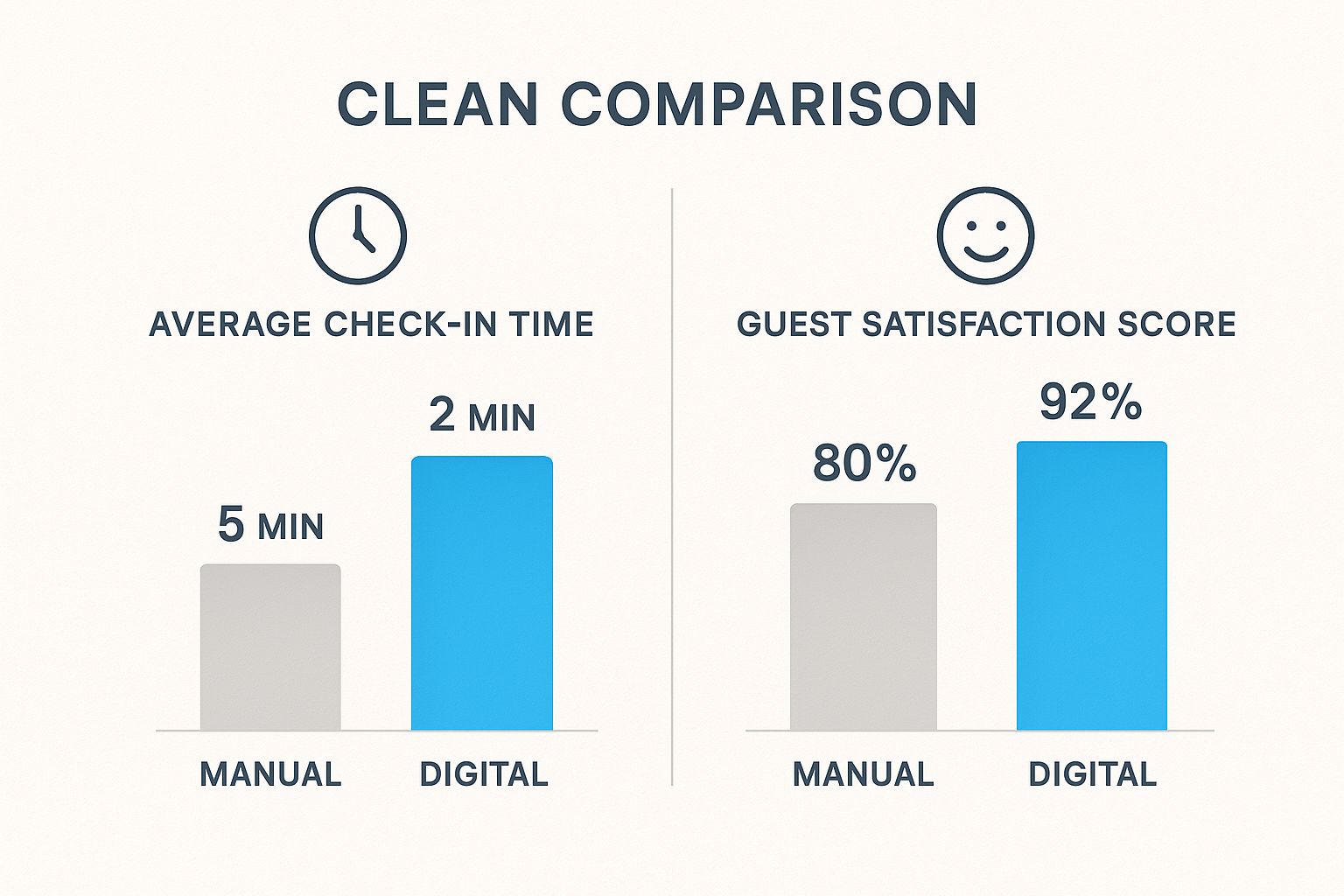
As you can see, a digital approach doesn’t just accelerate the process. It also significantly boosts guest satisfaction, proving how modernising the front desk can positively impact your business.
As the role has evolved, so have the tools and expectations. Technology hasn't replaced the need for skilled people; it has amplified their capabilities, shifting the focus from manual data entry to strategic oversight.
Here’s a look at how the role has transformed:
Traditional vs Modern Front Desk Responsibilities
| Responsibility Area | Traditional Approach (Manual) | Modern Approach (Tech-Enabled) |
|---|---|---|
| Visitor Check-In | Pen-and-paper logbooks, manual badge writing. | Digital sign-in kiosks, pre-registration, QR codes. |
| Host Notification | Phone calls to extensions, hoping someone answers. | Instant automated SMS and email notifications. |
| Security | Visual checks, relying on memory. | Photo capture, badge printing, watchlist screening. |
| Meeting Rooms | Whiteboards, shared calendars prone to conflicts. | Integrated booking systems with real-time availability. |
| Mail & Deliveries | Manual sorting and hand-delivery. | Automated logging, notifications for package pickup. |
| Communication | Answering a switchboard, taking messages by hand. | Directing calls, managing digital enquiries, providing info. |
This shift empowers the front desk team to be more proactive and efficient, turning a traditionally reactive role into an operational powerhouse.
Coordinating Workplace Logistics
Beyond welcoming people, the front desk is mission control for internal logistics. They coordinate meeting rooms—ensuring spaces are ready and preventing double-bookings that disrupt schedules. A well-run front desk becomes the single source of truth for resource availability.
They also manage the constant flow of mail and deliveries. An effective team ensures:
- Incoming Mail: Every letter and package is received, logged, and promptly delivered to the correct recipient.
- Outgoing Shipments: Couriers are booked efficiently, and parcels are ready for timely pickup.
- Security: All deliveries are checked against company policy, preventing unauthorised items from entering.
This smooth handling of logistics prevents bottlenecks and keeps the business running efficiently, cementing the front desk's role as the backbone of operations.
Upholding Security and Communication
A crucial part of the job is acting as the first line of defence for workplace security. This involves more than watching the door; it means verifying appointments, issuing visitor badges, and ensuring every person on-site is accounted for—a critical function in an emergency.
A proactive front desk team doesn't just react; they anticipate needs and manage access control with precision. This vigilance is essential for maintaining a safe and secure environment.
Additionally, the team serves as a communication hub, responsible for routing calls, handling enquiries, and providing information. Their clarity and professionalism directly reflect the company's image. Mastering these diverse duties is what separates a good front desk from a truly exceptional one.
Tackling Common Front Desk Management Headaches
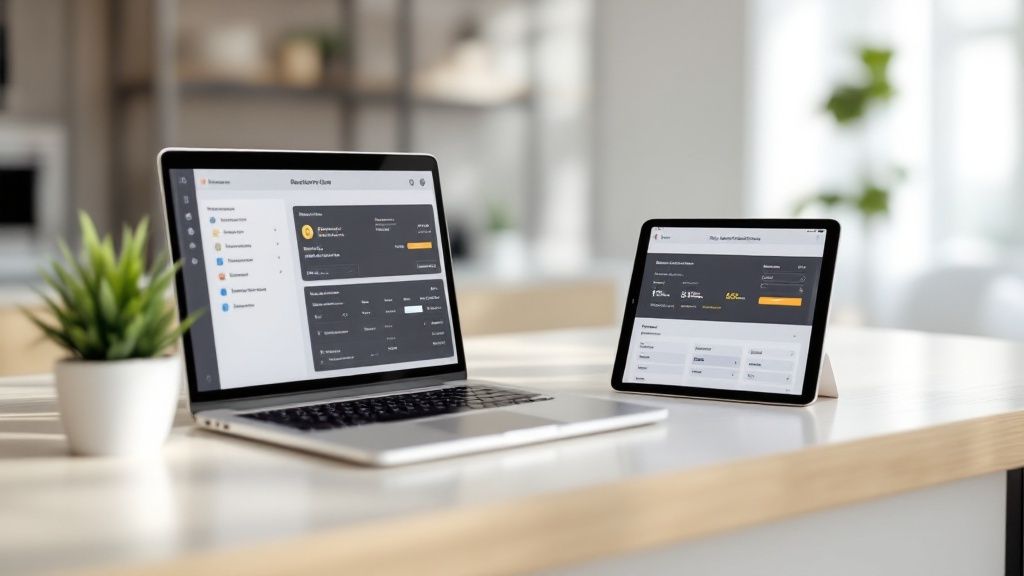
Even the most organised front desk faces challenges. Clunky processes and sudden disruptions can create a significant drag on your business, posing organisational risks that affect everything from brand reputation to the bottom line.
A slow, manual check-in process creates a poor first impression with a potential client. An overwhelmed receptionist juggling multiple tasks could easily miss a critical security detail, leaving your workplace vulnerable. These daily struggles add up, eroding both efficiency and morale. Your front desk, intended as a welcoming gateway, can become a bottleneck that frustrates visitors and stresses staff.
The Challenge of High Visitor Traffic
Managing a high volume of people, especially during peak hours, is a major challenge. When visitors, couriers, and staff arrive simultaneously, a manual sign-in book creates congestion, leading to long wait times and an unprofessional first impression.
The pressure on the front desk team becomes immense. Juggling phone calls, new arrivals, and a paper logbook is a recipe for errors and burnout. For a business, this translates into missed opportunities and a reputation for disorganisation.
A chaotic reception creates tangible security blind spots. When staff are overwhelmed, it's far easier for an unauthorised individual to slip past unnoticed, posing a direct threat to your people and property.
This constant pressure is a significant drain on morale. When front-of-house staff feel perpetually stressed, job satisfaction plummets, leading to higher employee turnover—a costly problem for any business.
Navigating Staff Shortages and Rising Costs
This operational strain is compounded by labour market challenges. Finding and retaining skilled front desk professionals has become increasingly difficult due to rising wage expectations. Many businesses struggle with understaffed and undertrained teams.
This is a widespread issue. In the Australian hospitality sector, for example, there's an ongoing struggle to recruit for these vital roles, driven by salary demands in an inflationary economy. To remain competitive, businesses must invest more in wages and hiring. You can discover more insights about the rising costs of front desk staffing and its budgetary impact.
When you're short-staffed, the problems multiply:
- Reduced Security: Fewer eyes on the entrance means less oversight and a higher risk of security breaches.
- Inconsistent Service: An overworked team cannot deliver the consistent, high-quality welcome that defines a professional brand.
- Increased Workload: Existing staff must pick up the slack, accelerating burnout and worsening the turnover problem.
These staffing issues directly threaten your operational stability, opening the door to security risks, reputational damage, and a poor workplace experience.
The Domino Effect of Inefficient Processes
Poor front desk management creates a domino effect throughout the company. A delayed visitor check-in can make an employee late for a crucial meeting, disrupting schedules and reducing productivity. A misplaced delivery could halt an entire project, causing frustrating and costly delays.
Over time, these "small" issues create a culture of inefficiency. Employees may start finding workarounds, viewing the front desk as a hindrance rather than a helpful hub. This breakdown erodes trust in internal systems. Ignoring these common headaches is a strategic failure that undermines security, productivity, and your company's reputation.
Transforming Your Front Desk with Technology
It's clear that traditional, manual front desk methods are no longer sufficient. The solution is technology designed for modern front desk management. A visitor management system (VMS) is more than just a tool; it's a complete operational upgrade for your reception area.
A VMS transforms your reception from a reactive cost centre into a proactive, data-driven hub. Imagine replacing a messy paper logbook with a sleek, intelligent dashboard. A logbook only tells you who came and went; a VMS provides real-time insights, automates repetitive tasks, and significantly strengthens your security. This shift frees your front desk team from manual data entry, allowing them to focus on what matters most: creating positive human interactions and managing the guest experience.
The Power of a Streamlined Welcome
A VMS delivers a vastly improved check-in experience. Long queues and cumbersome paperwork become a thing of the past. In fact, businesses can reduce visitor wait times by up to 86% by implementing a digital check-in system. This benefit goes beyond speed; it sets a professional, modern tone from the moment a visitor arrives.
This streamlined process delivers key advantages:
- Reduced Wait Times: Visitors can often pre-register before arrival, making their on-site check-in take mere seconds.
- Instant Host Notifications: The system automatically notifies employees via SMS, email, or team messaging apps when their guest arrives, ensuring a seamless handover without the receptionist having to track them down.
- Consistent Professionalism: Every visitor receives the same efficient, organised welcome, reinforcing your brand's commitment to quality and respect for their time.
Fortifying Your First Line of Defence
Beyond making a great first impression, a VMS provides a serious security boost. Manual logbooks are notoriously unreliable. In contrast, a digital system creates a secure, searchable, and accurate record of everyone who enters your building.
This technology hardens your security in tangible ways. You can capture visitor photos, print professional ID badges with expiry dates, and have visitors sign NDAs or safety policies directly during check-in.
By digitising your visitor log, you gain the ability to screen guests against internal or external watchlists automatically. This transforms your front desk from a passive entry point into an active component of your security strategy.
This capability is critical for compliance in regulated industries and provides peace of mind for any organisation. To understand how advanced this technology has become, learning what an AI receptionist is can reveal new possibilities for modern front desk operations.
Unlocking Actionable Business Insights
One of the most powerful benefits of a VMS is the data it collects. A digital system helps you make sense of visitor traffic, allowing you to analyse patterns, pinpoint busy periods, and see which departments receive the most visitors.
This data enables smarter business decisions:
- Optimise Staffing: Use traffic data to ensure your front desk is adequately staffed during peak hours, preventing queues and reducing team stress.
- Improve Facility Management: Track meeting room usage and visitor flow to make informed decisions about office layout and resource allocation.
- Enhance Compliance: Generate detailed visitor reports in seconds for audits or emergencies, ensuring you meet regulatory requirements with ease.
This data-driven approach helps you fine-tune processes, boost efficiency, and justify budgets with concrete facts. If you're considering this technology, exploring the benefits of a dedicated reception iPad app can be an effective starting point. By adopting a VMS, you're not just fixing old problems; you're building a smarter, safer, and more efficient workplace.
How to Implement a Visitor Management System

Implementing new technology at your front desk can feel daunting, but with proper planning, it can be a smooth process. This is more than a software installation; it's an opportunity to upgrade your organisation’s security, efficiency, and first impression. The journey begins with your people and processes, not the technology. A clear plan ensures you select a solution that solves your unique challenges.
Assess Your Current Front Desk Needs
First, conduct a thorough assessment of your current front desk operations. What are the biggest pain points for your team and visitors? Identifying these issues will clarify what a new system must accomplish.
Start by asking key questions:
- Visitor Volume: How many visitors, contractors, and deliveries do you handle daily? Are there peak times that create bottlenecks?
- Security Requirements: What level of security do you need? Is a simple log sufficient, or do you require photo capture, visitor badges, NDAs, and safety waivers?
- Compliance Needs: Does your industry require detailed, easily accessible visitor logs for audits or emergency evacuations?
- Current Inefficiencies: Where is time being wasted? Is it spent making phone calls to notify hosts or managing paper logbooks and deliveries?
Answering these questions builds a strong business case for change. It's worth noting that organisations with high employee engagement—which begins with a great workplace experience—are 21% more profitable. A streamlined VMS contributes directly to a better environment for everyone, impacting your bottom line.
Choose a System Based on Benefits
Once your needs are clear, you can evaluate VMS options. Instead of getting lost in features, focus on the real-world benefits each system offers and how they address your specific challenges.
Look for a system that delivers value in these key areas:
- Enhanced Security: A safer workplace is the primary benefit. Look for real-time visitor tracking, instant host notifications, and customisable emergency evacuation plans.
- Improved Efficiency: Free up your front desk team by automating repetitive tasks. Pre-registration links and automated alerts are significant time-savers that boost productivity.
- Superior Visitor Experience: Create a seamless and professional welcome. A system with QR code check-ins and a simple, branded interface shows visitors you value their time.
- Actionable Insights: Gain access to data on visitor traffic and peak hours. This information is invaluable for optimising staffing and facility management.
Plan the Rollout and Train Your Team
A successful launch depends on a clear rollout plan and effective team training. Even the best system will fail if your team doesn't understand its purpose or how to use it.
A well-planned training program is the single most important factor in ensuring high adoption rates for new workplace technology. When staff feel confident and supported, they become champions for the change.
Break your implementation plan into simple steps:
- Set a Timeline: Map out the project in phases, from initial setup to a pilot test with a small group of users.
- Communicate the "Why": Explain how the new system will benefit everyone—from faster guest arrivals to improved security for all.
- Provide Hands-On Training: Walk your front desk staff through daily workflows, showing them how the VMS makes their job easier.
- Gather Feedback: After going live, collect feedback from staff and visitors to identify any issues and fine-tune your processes.
Best Practices for an Exceptional Guest Experience
Technology can handle the heavy lifting, but it can't replace a genuine human connection. The magic of an exceptional guest experience happens when you blend the efficiency of a visitor management system with the warmth of a personal touch. This combination turns a simple check-in into a positive, lasting impression.
Achieving this balance requires a commitment to continuous improvement. By empowering your team with the right skills and clear processes, they can stop worrying about procedures and focus on what truly matters: making every visitor feel welcome and secure.
Empower Your Team Through Continuous Training
Your front desk team is your greatest asset. While technology manages repetitive tasks, your people navigate complex situations, show empathy, and think critically. Therefore, ongoing training is not a luxury—it's a necessity.
A great training program should build a well-rounded team with both technical and interpersonal skills.
- Customer Service Excellence: Equip your staff to handle any situation with grace, including de-escalation techniques and active listening skills.
- Security Protocol Mastery: Regular drills on emergency procedures, data privacy, and identifying suspicious behaviour transform your front desk into a vigilant security asset.
- Technical Competence: Ensure everyone is comfortable with the VMS, from checking in a visitor to pulling an emergency evacuation report.
To excel in this area, consider adapting proven customer support best practices for your front-of-house environment.
Standardise Procedures for a Consistent Welcome
Consistency is the hallmark of professionalism. Every person who enters your building should receive the same high-quality welcome, regardless of who is at the desk. Standardised procedures eliminate guesswork and create a smooth experience for everyone.
Create a clear playbook for common front desk scenarios, from greeting a VIP to handling an unnamed delivery.
A standardised welcome process does more than ensure efficiency; it communicates that your organisation is professional and values your visitors' time. This consistency builds trust from the first interaction.
This consistent approach is also vital for security and compliance. When everyone follows the same steps for visitor verification and data handling, you significantly reduce the risk of human error.
Leverage Data for Proactive Improvements
Your visitor management system collects a wealth of data that can be used for strategic improvements. Instead of reacting to problems, you can use these insights to proactively enhance the guest experience.
By analysing visitor traffic patterns, you can identify your busiest periods and optimise staff schedules to prevent queues and reduce team stress. This data-driven approach ensures you always have adequate coverage.
You can also use VMS data to:
- Refine Security Measures: Track contractor movements or identify high-traffic areas to better allocate security resources.
- Improve Facility Management: Analyse meeting room usage to inform decisions on cleaning, maintenance, and resource allocation.
- Enhance the Visitor Journey: Review check-in times and visitor feedback to identify and eliminate bottlenecks in your welcome process.
This data-driven mindset allows for continuous improvement. It's also critical for addressing broader operational issues. For example, recent reports show that disengagement can cost a business up to 33% of an employee's salary in lost productivity. By using data to support your team and simplify their work, you can boost morale and deliver a more reliable service. You can learn more about Australian workforce trends and their impact on operational efficiency.
By combining a well-trained team, consistent procedures, and data-driven insights, you can elevate your front desk from an administrative function to a strategic asset that enhances security, efficiency, and your company's reputation.
Ready to transform your front desk into a hub of efficiency and security? Discover how VisitUs can provide a seamless, secure, and professional welcome for every visitor. Learn more about our visitor management solutions today!
